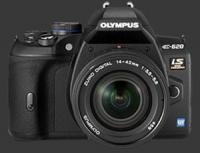Canon EOS Rebel SL1 Review
Canon EOS Rebel SL1 Usability - How easy is it to use?
The Canon SL1 is the smallest DSLR ever. Impressively, it is even smaller than the discontinued Olympus Evolt E-620
Olympus Evolt E-620 Four-Thirds DSLR which is only slightly slimmer while using a 2X-crop sensor. Canon managed this feat with a unique design that retains the same number of controls as other members of the Rebel family.
The SL1 is less than twice the width of its lens EF-S mount. Its rounded body protrudes slightly more than the lens-release button on the left. The right side has a cleverly designed grip that places the shutter-release on a shelf above the photographer's fingers. This puts it at a comfortable distance while allowing for a narrow grip.
This camera feels light for its size. Indeed, at 407g, there plenty of heavier fixed-lens cameras. As a DSLR, its body is largely hollow to accommodate the reflex mirror and place the mount at the right flange distance. Canon also saved weight by using a pentamirror rather than pentaprism for the viewfinder. The expected consequence is a relatively small and dim view.
With a smallish lens attached, the SL1 is comfortable to hold. The grip is tight yet allows for a firm hold over the camera. The two-stage shutter-release is well-positioned. Its half-point has a moderate amount of travel and a distinct feel. The camera's single control-dial, just behind the shutter-release, is easy to reach too.

There is a small direct ISO button to the left of the control-dial. It shows available ISO settings on the rear LCD. A particular setting is chosen when the control-dial or 4-way controller. It is rather efficient since there is no need to press anything to confirm. Few entry-level DSLRs have an ISO button, so this one is very welcome.
A traditional mode-dial is located on the same side of the camera. It has 12 positions, including the ubiquitous PATM modes. Four scene modes gets distinct positions and the last size are grouped into SCN. There are two Auto modes and a No Flash mode as well. The mode-dial has good detents to prevent accidental changes.
A 3-position power button sits next the mode-dial. It positions are: Off, On and Video. This last one automatically engages Live-View and activates the Video-Record button on the rear. This thankfully means the Rebel SL1 has a dedicated video mode and is therefore ready before filming.
The top-plate features a standard hot-shoe plus a built-in popup flash. One can also see a small speaker and built-in mono microphone on the left shoulder. There are recessed eyelets for a shoulder-strap. These make a camera-strap unobtrusive and more comfortable than usual.

The back of the Canon Rebel SL1 is very busy. A 3" touchscreen LCD with 3:2 aspect-ratio covers most of the surface. Above the LCD, there is a small optical viewfinder with an Eye-Start sensor on top. It turns off the LCD automatically when taking the camera to your eye. Left of the OVF, there is a Menu and an Info button that work exactly as expected. On the other side, a button toggles Live-View or starts and stops video capture.
The rear LCD has a 1 megapixel resolution which make it very sharp. Note that the SL1 loads a low-resolution version of images first in Playback mode. To inspect fine-details, one must wait for the high-resolution version to finish loading then. During Live-View, the LCD is Exposure-Priority which means it accurately previews what the resulting exposure should be, even outside the exposure-range of the camera and lens. The optional Live-Histogram is just as accurate. Kudos to Canon for getting this right!
Like all digital cameras, the SL1 can automatically show an image after each shot. This Instant Review function unfortunately is distinct from Playback mode. While Info can still cycle over display modes, the image shown cannot be changed or magnified. This is also true with continuous drive where only the last image captured is shown. One needs to press the Playback button in order to check focus accuracy or compare images from a burst.
A soft rubber-coated area at the upper-right corner of the LCD serves as thumb-rest. To its left, the Focus-Point Selection and AE-L button are labelled with Canon's usual icons. These are used to zoom in Playback mode. The AE-L button locks exposure until a shot is taken. Unfortunately, pressing it again does not release the lock.

The EC button finds itself along the right edge of the LCD where it is rather poorly-placed and too low on the body. This means that the user must shift is grip slightly to dial in EC or change aperture in Manual exposure-mode. Too bad there is no option to swap it with the Live-View button which has a premium location is, most-likely, much less used.
A 4-way controller made of a single ring, plus the central button, is found below the EC button. The central Q button lets the status shown on the rear LCD to be edited directly. Simply select the option to edit using the 4-way controller and change it with the control-dial.
The last two buttons, next to the lower-edge of the camera, are Playback and Delete. Both work as usual and the SL1 is Shooting-Priority. Delete has no function in Capture mode. The left of the camera has two more buttons. The top one releases the flash, while the bottom one activated Depth-of-Field preview, something not always present on entry-level DSLRs.

The bottom of the camera has a metal tripod-thread, inline with the optical center of the lens, which is ideal. There is also a very sturdy door with a small latch. The compartment behind it houses both the proprietary Lithium-Ion battery and SDXC memory card slot.
 |
Please Support Neocamera
All information on Neocamera is provided free of charge yet running this website is a huge endeavor. Purchases made via affiliate links found throughout the site help keep it running and up-to-date. There is no additional cost to you, so please consider buying via these links to our affilates:
If you found any information on this site valuable and did not purchase via our affiliate links, please considering donating via PayPal:
Any amount will be greatly appreaciated. Thank you for your support!
Canon Rebel SL1 Highlights

Sensor-Size: 22 x 15mm

Actual size when viewed at 100 DPI
| 18 Megapixels DSLR | ISO 100-12800 |
| Canon EF Mount 1.6X FLM | Shutter 1/4000-30s |
| 95% Coverage Medium Viewfinder | Full manual controls, including Manual Focus |
| Automatic Eye-Start sensor | Custom white-balance with 2 axis fine-tuning |
| Built-in Dust Reduction | Spot-Metering |
| 4 FPS Drive, 1140 Images | Hot-Shoe |
| 1920x1080 @ 30 FPS Video Recording | Stereo audio input |
| 3" LCD 1 Megapixels | Lithium-Ion Battery |
| Secure Digital Extended Capacity |
Updates
2025.01.18

Fujifilm GFX 2025 Lens Roundup
Lens Review roundup of Fujifilm GFX Medium-Format lenses. Quality, performance and handling of the GF20-35mm F/4R WR, GF30mm F/3.5 Tilt-Shift and the GF55mm F/1.7.
2024.11.18

Best 2024 Photography Gifts for Every Budget
Great gifts for photographers and photo enthusiasts selected for every budget among the best products of 2024.
2024.08.07

Eye Protection Tips for Professional Photographers
The four main considerations for professional photographers regarding eyewear.
2024.07.14

Fujifilm X100VI Review
Flagship fixed-lens compact digital camera with a 40 MP sensor and Image-Stabilization, a first for the series. Retro design featuring dual control-dials, plus direct ISO, Shutter-Speed and EC dials. Its hybrid viewfinder can switch between EVF and OVF mode.
2024.05.09

Fujifilm GFX100 II Review
Flagship 102 Megapixels Medium-Format Mirrorless Digital Camera with 8-Stop 5-Axis IBIS, 8 FPS Drive, 8K Video and 400 MP Super-Resolution capture in a weatherproof and freezeproof body with dual control-dials and dual memory-card slots.
2024.04.03

Fujifilm X-T5 Review
Newest Fujifilm flagship boasting a 40 MP APS-C sensor, 5-axis IBIS with 7-stop efficiency, 15 FPS continuous drive, 6.2K Video capture, dual control-dials and dual SDXC UHS-II slots in a sturdy weatherproof and freezeproof body.
2023.11.20

Best Digital Cameras of 2023
Find out which are the Best Digital Cameras of 2023. All the new Mirrorless Digital Cameras from entry-level to high-end professional.
2023.07.10

Fujifilm X-H2 Review
40 Megapixels APS-C Hybrid Mirrorless Digital Camera with 7-stop IBIS. Fastest shutter ever and 8K video capture. Large builtin EVF with 0.8X magnification and 5.8 MP, plus an Eye-Start Sensor. Packed with features and large number of controls in a weatherproof and freezeproof body.
2023.05.07

Sony FE 20-70mm F/4G Review
Review of the unique Sony FE 20-70mm F/4G lens. The optical zoom of this lens spans ultra-wide-angle and medium focal-length coverage, making it one of the most versatile Full-Frame lenses on the market.
2023.01.15

Huion Inspiroy Dial 2 Review
Review of the Huion Inspiroy Dial 2 tablet, a medium sized drawing surface with dual dials and customizable buttons. Connects via USB-C or Bluetooth 5.0 with Windows, Linux and Android support.
2022.12.08

How to Pack for a Photo Trip
Find out how to pack for a travel photography trip, carry your gear safely while meeting airline regulations.
2022.11.13

Best Digital Cameras of 2022
The best digital cameras of 2022. A short list of the most outstanding models in their respective categories. Choose one for yourself or as a gift.











